Ezaki Kinenkan
Getting an Understanding of Ezaki Glico’s History
History of Glico Group
Steadily growing through warm support
1882
The founder, Ri-ichi Ezaki, was born in Hasuike village, Saga prefecture, in the south of Japan
1883
Ri-ichi’s father, Seishichi Ezaki, starts a medicine business
1901
Seishichi Ezaki passes away and leaves the family in debts
1915
Ri-ichi’s starts a wine business
1919
Ri-ichi remembers that oyster broth provides a good source of glycogen and sends a sample of the broth to Kyushu university for research.
1920
The result of the research verified that the broth indeed contains glycogen.
Ri-ichi decides to make glycogen into a business and comes up with Glico’s name, trademark and catchphrase.
1921
Invents and test markets his “Glico Nutritional Snack”(Glico)
1922
Launches “Glico” at the Osaka Mitsukoshi Department Store. Subsequently, February 11 becomes Ezaki Glico’s Foundation Day
1925
Establishes the Toyosaki Factory in Toyosaki, Osaka City
1927
Introduces the idea of including toys with the candy
1931
Installs Glico vending machines with built-in films in various locations, including Tokyo department stores.
Establishes the Osaka Factory in Utajima, Osaka City - the current location of Glico headquarters
1932
Establishes the Dalian Factory in China and expands into the mainland and southern regions
1933
Launch of “Bisco,” a yeast biscuit
1934
Establishes the “Mother and Child Health Foundation”
1935
Installes a neon sign in Ebisubashi, Southern Osaka
1937
Establishes the Tokyo Factory
1945
The Osaka and Tokyo factories were completely burned down due to air raids. The company loses domestic and foreign factories and assets with the end of the war
1951
Osaka and Tokyo factories rebuilt
1953
Establishes the Kyushu Factory
1955
Launch of “Almond Glico”
1956
Starts producing and selling seasonings
Establishes Glico Dairy Co., Ltd. in Saga Prefecture
Established Glico Food Co., Ltd.
1957
Starts producing wheat starch
1958
Launch of “Almond Chocolate”
1959
Starts manufacturing and selling ham/sausage products
1960
Launch of “One-Touch Curry”
1961
Launch of “A-glu/vital wheat protein”
Establishes Glico Nasu Farming Cooperative Co., Ltd.
1962
Launch of “Pretz“
1963
Launch of “Glico Cone” (later renamed Giant Corn)
1966
Merger of seven Glico Dairy Co., Ltd companies
Launch of “Pocky Chocolate”
1967
Establishes Glico Farming
Consolidation of Glico Nasu Farming Cooperative Co., Ltd.
1969
Launch of “Yogurt Health”
Starts selling hamburger patties
1970
Establishes Thai Glico Co., Ltd. to fully expand into the Asian market
1972
Completion of Ezaki Memorial Hall
Launches food coloring “Monas Color”
Launch of “Pucchin Purin”
1973
Launch of “Kougen Milk” (100ml pack)
1976
Launch of “Fresh Noodles Mendoki”
Renames Glico Farming Co., Ltd. as Glico Ham Co., Ltd.
1978
Launch of “Panappu”
1979
Launch of “Café Au Lait”
1982
Foundation of Glico Foods Co., Ltd. after the merger of Ezaki Glico Foods Co., Ltd. and Glico Ham Co., Ltd.
Set up Generale Biscuit Glico France (GBGF) in France and launches Pocky chocolate under the name of “Mikado”
1985
Starts “Seventeen Ice” vending machine business
1986
Sets up a biochemical research laboratory focused on bio-technology
Launch of “LEE” (boil-in-the-bag beef curry)
Launch of “Aisu No Mi” ice cream
1988
Opens the confectionery factory museum “Glicopia Kobe”
1989
Launch of “DONBURI”(boil-in-the-bag rice topping)
1992
Announces a new company philosophy “A wholesome life in the best of taste”, a new Glico spirit “Achieve innovation, cheerfulness, and the thrill of the positive!”, and a new company logo.
1995
Launches “Juku Curry”.
Sets up Shanghai Glico Foods Co., Ltd. to expand the business to full-scale in China
1996
Launches the website “Glico Wonder Restaurant”
1997
Launch of “Choshoku Ringo Yogurt”.
1998
Completes the refurbishment of the famous Glico neon sign at Ebisubashi in Minami area of Osaka for the fifth time
1999
Designates November 11 as “Pocky & Pretz Day”
2000
Renames Glico Dairy Co., Ltd. as Glico Dairy Products Co., Ltd., which becomes a 100% Glico subsidiary.
ISO14001 Certification (Environment Management System) is granted to Ezaki Glico HQ and all its manufacturing companies
2001
Baby formula manufacturer ICREO joins the Glico Group
2002
Starts a full-scale Office Glico business operation.
Establishes a standard of conduct for the Glico Group.
2003
Set up of Ezaki Glico USA Co., Ltd.
Launches a food for special health uses “POs-Ca”.
Launch of “Calorie Control Ice”
2004
Launch of “ZEPPIN curry”
2005
Launch of “Mental balance chocolate: GABA”
2007
Launch of “Dororich”
2008
Launch of “Cheeza”
2009
Launch of “ICREO Balance Milk” and “ICREO Follow-up Milk”
2010
The “Glico Wagon” starts its journey through Japan from Hokkaido to Okinawa
2012
Event to celebrate its 90th anniversary with regular clients and business connections.
Divides the Glico Foods Co., Ltd.’s food ingredient business to set up Glico Ham. Co., Ltd. and Glico Nutrition Co., Ltd.
Opening of “Glicopia East” in Saitama prefecture
Official launch of “Pocky” in Vietnam and Indonesia
2013
Launch of “Pocky” in South Korea.
Set up of “Glico Wings” ice cream business in Indonesia
2014
Launch of “Pocky” in Malaysia.
Transfer of all the shares of Glico Ham Co., Ltd.
Set up of “PT. Glico Indonesia” in Indonesia for confectionary sales.
6th generation of the neon sign board in Osaka city is presented to the public
Glycogen and the Glico Nutritional Snack
In Spring of 1919 (Taisho 8), Ri-ichi Ezaki, who was running a medicine business, saw some fishermen throwing away oyster broth at an embankment along the Ariake Sea in his hometown in Saga Prefecture. Upon seeing this, an article he had read in the Yakugyo Shimbun (a newspaper about medicine) came to his mind. In the article, it mentioned that “there are great quantities of glycogen contained in oysters, which is important for energy metabolism.” Ri-ichi thought, “Maybe there is glycogen contained in the broth as well?”, so he asked Kyushu University for an analysis. As a result, he found out that the stock contained lots of glycogen, along with other nutrients such as calcium and copper.
This dramatic discovery strengthened Ri-ichi'sesire: “I want to spread the use of glycogen!” At first, he started using it as a medicine, but he received advice from a professor at Kyushu University: “What is important is prevention by developing a body that doesn’t get sick.” This is when he thought and decided, “I see. If prevention comes first over treatment, then I will utilize this to promote good health.”
Ri-ichi thought, “Those who need glycogen the most are children during their growth period!” He then wanted to include it in caramel, which was growing in popularity at the time, especially as a western snack that children enjoyed eating. This was the beginning of the “Glico Nutritional Snack”.
During this period, the number of caramel businesses declined from close to 50 to less than 10, and the road ahead wasn’t easy. Under these circumstances, a special quality absent in competitors’ products was necessary, even if it was a nutritional snack that used glycogen. After imagining and devising a plan, Ri-ichi decided to create a name, package and trademark that stood out more than his competitors.
The name was decided as “Glico”, originating from glycogen, which was simple and easy to remember. The color of the box was decided as a distinctive red color that was stylish and promoted appetite - and the special red boxes were born.

Subsequently, he thought about how to design the trademark. Whenever Ri-ichi had something on his mind, he would visit a Shinto shrine near his house. One day, he saw children holding a footrace in the shrine, and got a vivid image of a child running past a finish line with both arms up.
He thought, “This is it!” Children running past finish lines were full of energy, and playing led to sports, which was a ticket to good health. The goal-in pose was decided as the trademark. Ri-ichi checked to see if the goal-in mark was popular by having elementary school students check his potential trademarks. Without even knowing, he was conducting what is known today as marketing research.
When Ri-ichi discovered glycogen, besides running the medicine business he inherited from his father, he was also known as one of the best wine businesses in Kyushu. In Spring of 1921 (Taisho 10), in order to sell the Nutritional Snack Glico nationwide, Ri-ichi moved to the commercial capital, Osaka, with his entire family.
Ri-ichi came up with the idea of making heart-shaped candies. The heart symbolizes a heart that is compassionate about health, and he tried to improve its texture by eliminating any sharp edges.
This idea was extremely complicated to accomplish from a manufacturing standpoint. He was told by specialists that the caramels needed to be formed into cubic shapes, because there was no equipment for making heart-shaped caramels. He decided to develop this equipment at his own company through research, and succeeded in creating a “heart shape roller”.
Subsequently, in 1930 (Showa 5), he invented the vacuum kiln. He succeeded in minimizing the imperfection of caramel candy which, up to this time, would easily deform during the hot summer periods. Both of these technological developments were ideas gained from the customer’s standpoint.
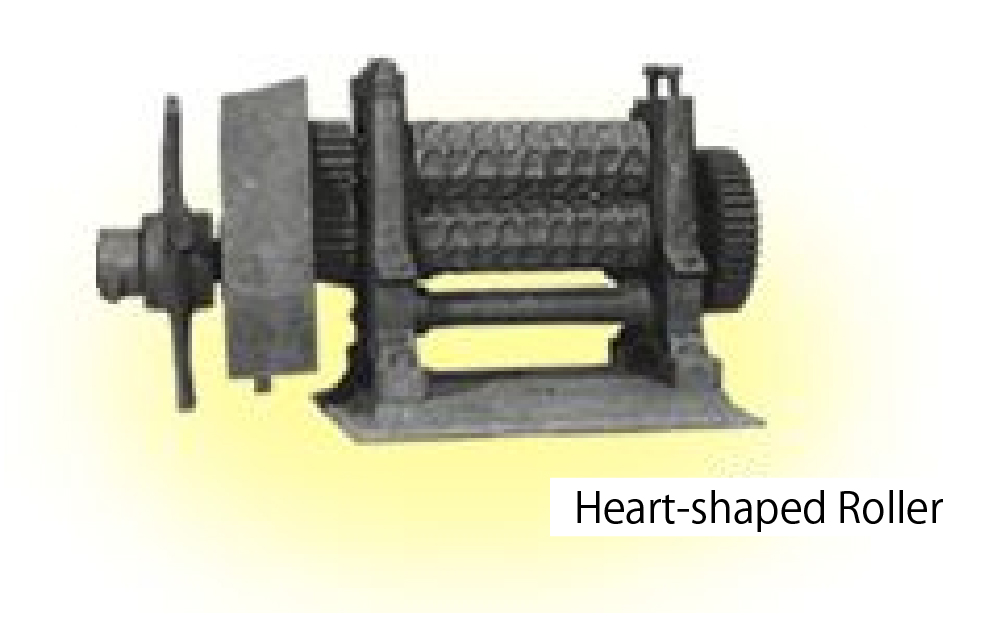
While Ri-ichi was confident in his product, the newly established company’s big challenge was how it could get city retailers to carry its product. Ri-ichi thought of a strategy: if the product was offered for sale at the most reputable shop - like rolling a stone from the top of a mountain - general retailers should start carrying them too.
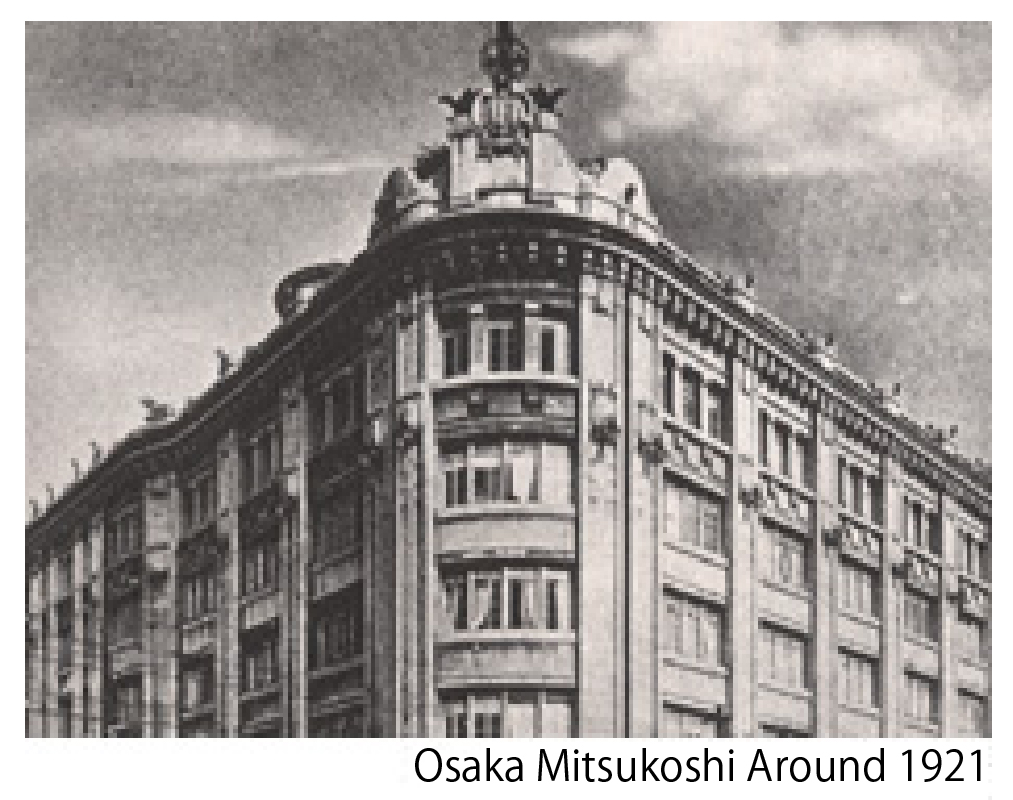
Ri-ichi visited the Mitsukoshi department store in Kitahama, Osaka, and no matter how many times he was turned down, he kept going back to highlight his nutritious confectionery's distinctive characteristics. Since he was so passionate about them, at last Mitsukoshi said, "Let’s try carrying them.", and agreed to sell them.
Subsequently Ri-ichi decided that 11 February 1922, the day that Glico was offered for sale at Mitsukoshi, would be the anniversary of the founding of Ezaki Glico. Since then, after overcoming numerous difficulties, Ezaki Glico delivers "A wholesome life in the best of taste" to people from every generation and every country.
History of the Runner Crossing the Finish Line Trademark

1922-1928
1928-1945
1945-1953
1953-1966
1966-1971
1971-1992
1992-
Long-selling Products
Glico
1922 Asobi Glico
Today, we deliver a wholesome life in the best of taste together with dreams to your precious child with ‘Asobi Glico’, currently with wooden toys to play with.
Bisco

1933
Glico’s second product Bisco is a cream sandwich biscuit, which was born from kneading healthy yeast into cream. Currently, lactic acid bacteria is used replaced the yeast.
A-glu
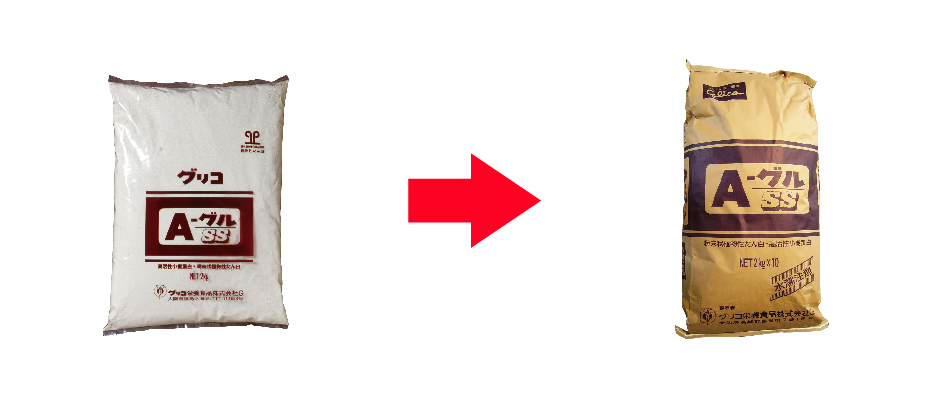
‘A-glu’ (wheat gluten) is Japan’s first "powdered wheat gluten" and currently has the largest market share in Japanese history.
Icreo Balance Milk
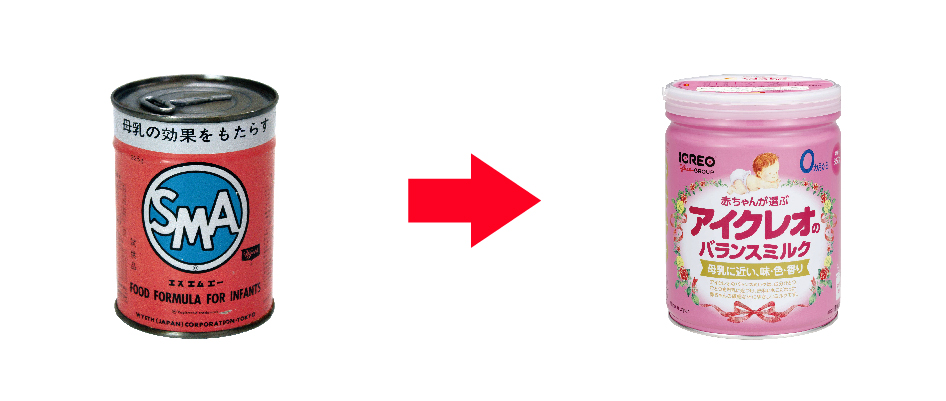
Powdered milk born from a strong desire to create milk that resembles breast milk for babies.
Pretz
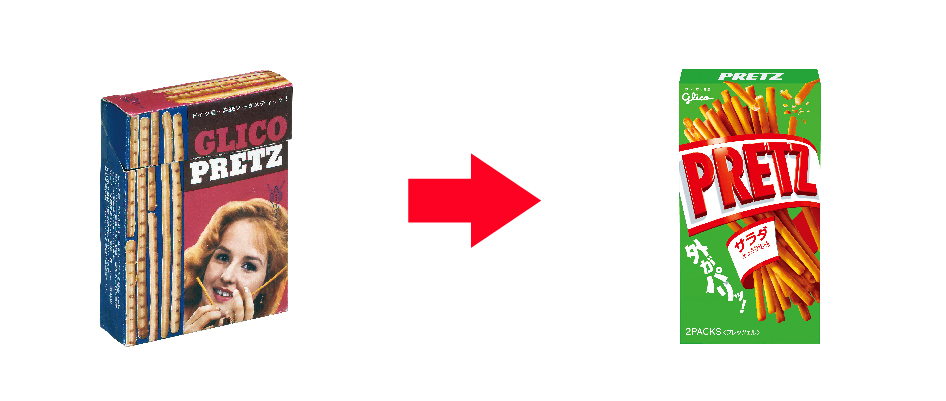
Inspired by pretzels, a popular German snack, ‘Pretz’ started out as a snack for Japanese adults. We quickly shifted the focus to developing a snack for children and it became a big hit.
Giant Cone

We developed a technology to coat the inside of the cone with chocolate without dampening the it so that it stays crispy.
Pocky Chocolate
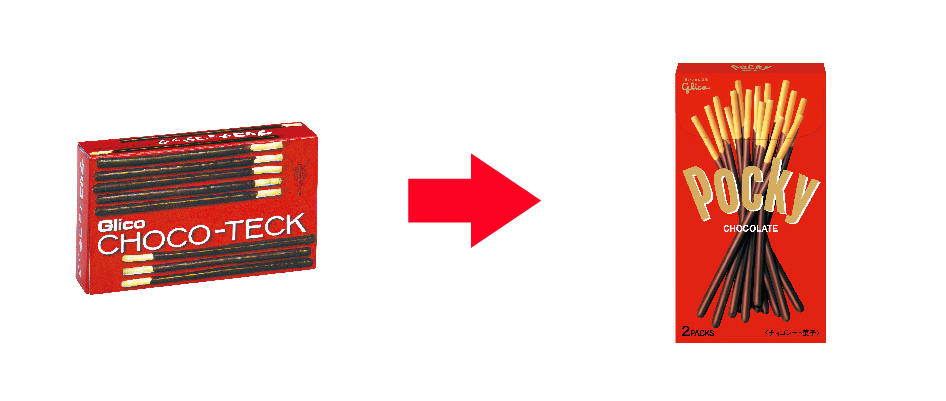
A chocolate snack that has a part that is not covered with chocolate so you can eat it without getting your hands dirty. The product’s name was inspired by the onomatopoeic snapping sound made while eating it – pokkin pokkin – to the Japanese ear.
Giant Caplico
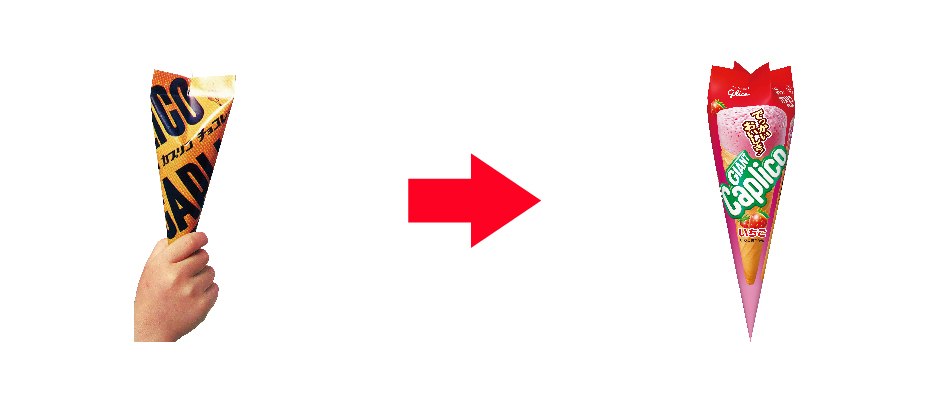
A unique cone that naturally makes you want to ‘capli’ (bite) into it. It debuted as a product that provides filling happiness and fun.
Cream Collon
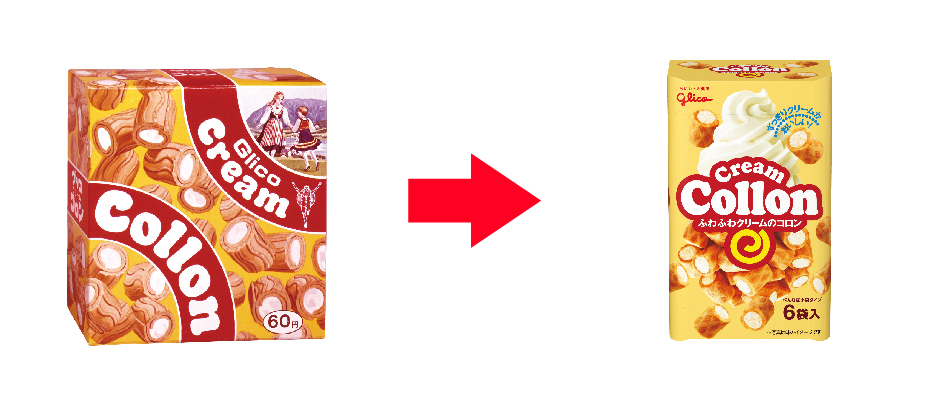
It was named Collon (cylinder), inspired by – colo colo – the Japanese onomatopoeic sound made when something round is rolling.
Pucchin Purin
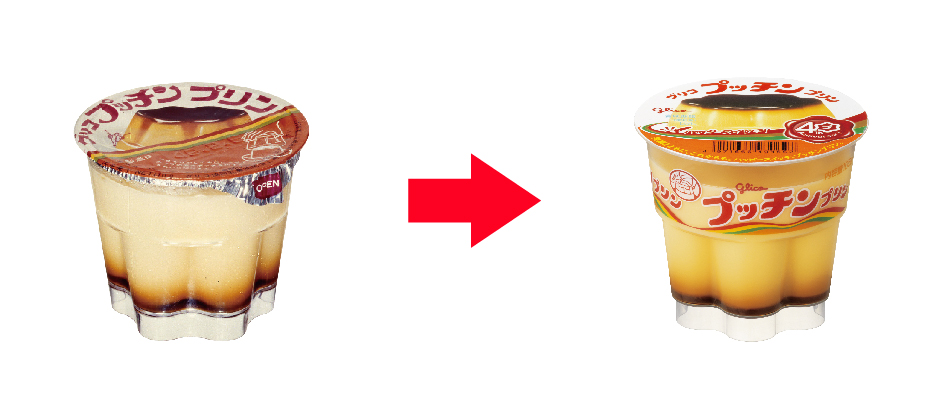
‘The pucchin stick is a happiness switch!’ that makes children throughout Japan smile. These thoughts were taken into consideration in its development (Pucchin stick=the stick at the bottom, which you brake to have the pudding slip out of its container)
Papico
It smashed the jinks, "white frozen desserts will not sell". It has been extremely popular since its debut on T.V.
Cafe' Au Lait
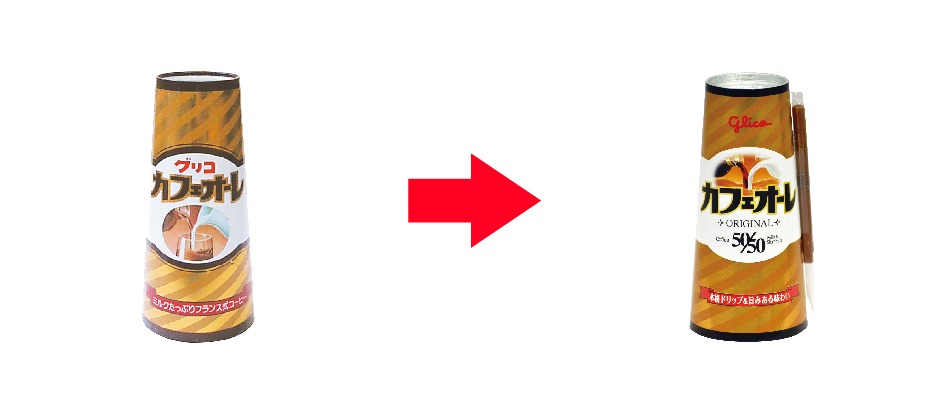
Taking into consideration environmental conservation, its container is made of paper and its cone-like shape was made to express the novelty of the product. It has a caramel aftertaste and contains powdered milk that has continued to be particular about maintaining the taste of breast milk.
Juku Curry
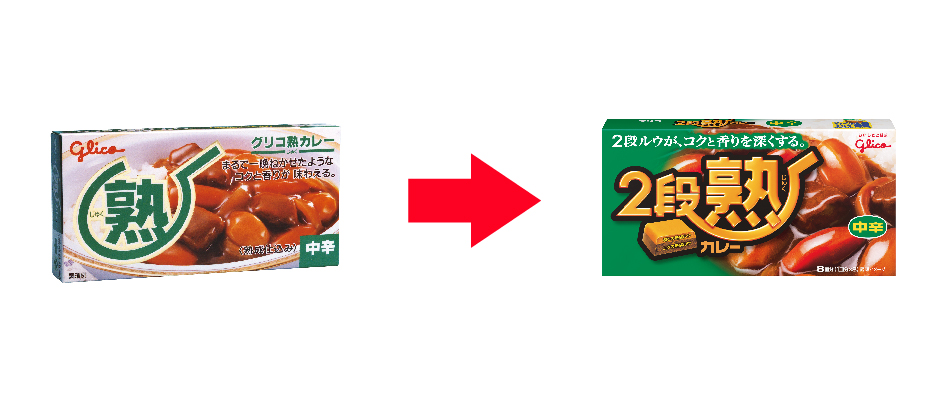
Its concept emerged from our production technology for confectionery
Breakfast Apple Yogurt (Choushoku Ringo)
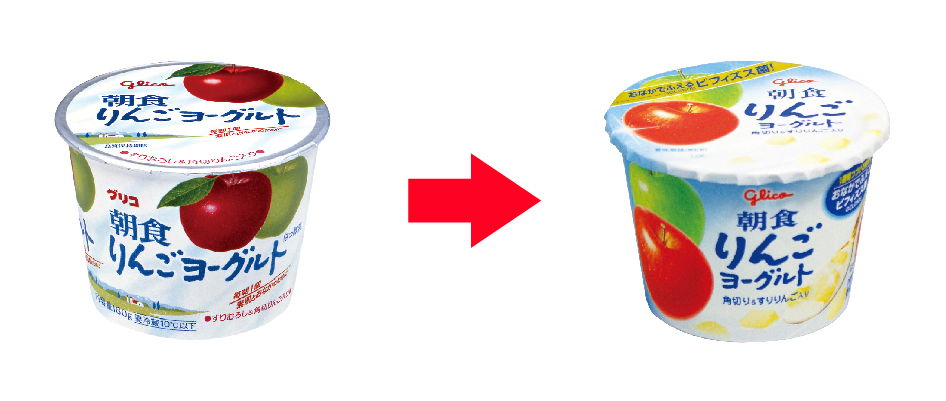
Apple Yogurt with real fruit.
The history of Glico toys
The Glico toys were created by Ri-ichi Ezaki, based on his belief that "eating and playing constitute the two great vocations of children".
Until now, more than 50,000,000,000 toys that encompassed more than 20,000 types have been produced.
Approximately 4,000 of his toys are exhibited in the Ezaki Memorial Hall.

The history of advertisement and Campaigns that were featured over the ages.
Newspaper advertisements in the early years of Showa Era
Even his newspaper advertisements embodied the spirit of his creative endeavor.
Utilizing the empty spaces in the newspaper, "Mamebun Ads (miniature ads)" that were published on a low budget, became an explosive boom. Thereafter, ads which no other but Ezaki could conceive, were constantly on the forefront down through the ages - ads such as "Daishi Ads (mount ads)", with the newspaper serving as the mount for goods to be exchanged, "Kabuto Ads (Helmet Ads)" that could be folded into a helmet by folding along the lines provided on the newspaper in which they were printed, and "Hatena Ads (I-Wonder-What Ads)" that came with quizzes, etc.
"Mamebun Ads, (low-budget miniature ads)"
It was in 1933, (the 8th year of the Showa Era), that "Mamebun Ads (low-budget miniature ads)", considered the masterpieces of newspaper ads, were born. They were thought as effective newspaper ads on a low budget.
These "Mamebun Ads", measuring 33 cm sq. and coming with illustrations and a "mini copy", were left with the newspaper agencies. They were asked to run them whenever there were empty spaces in the paper.
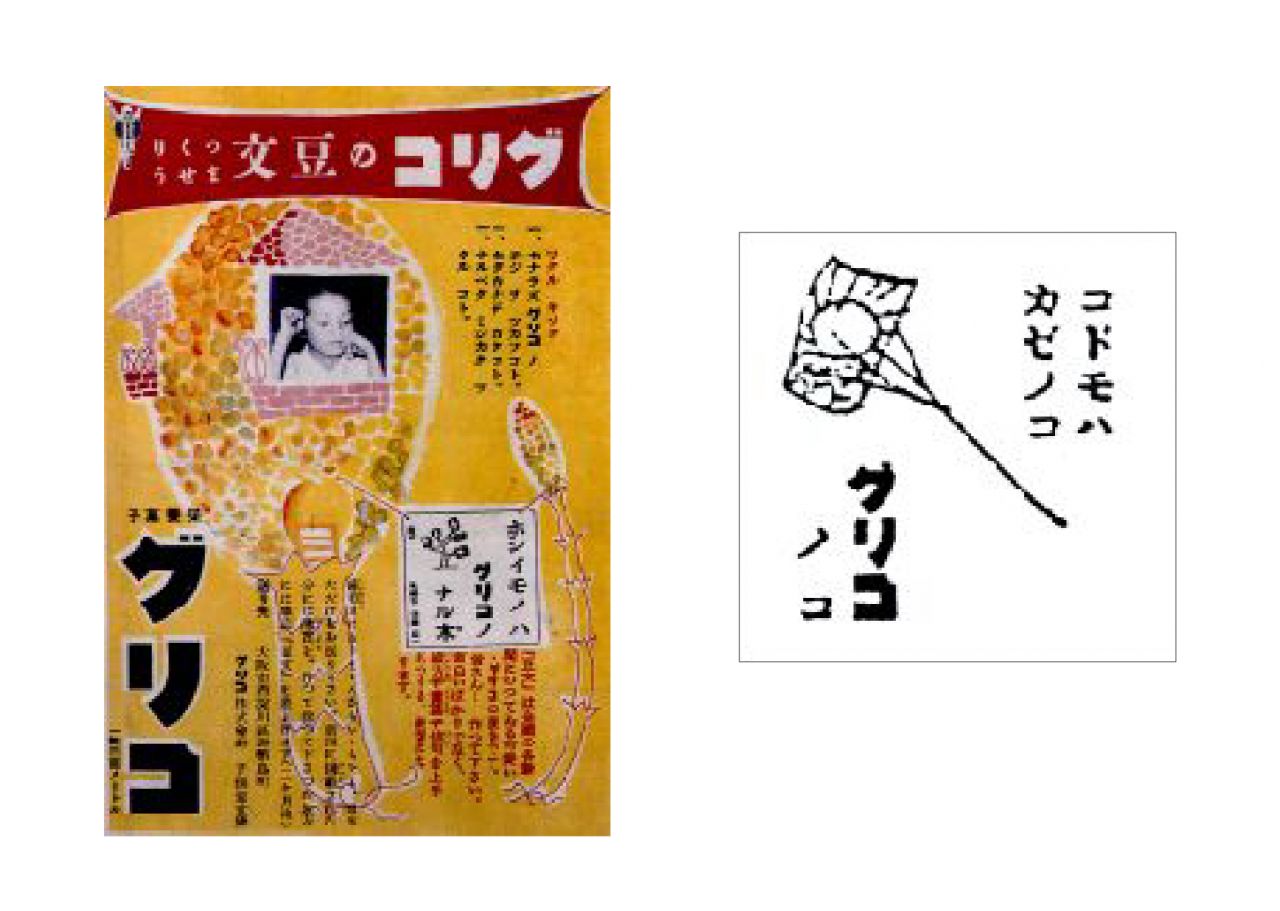
Ezaki Glico posters
The Ezaki Glico posters were seen all over Japan.
They caught the attention of everyone!
They were colorful and fun and every single one was characterized by the familiar letters of Glico, which would grab the viewer's attention.
The posters in the early years were focused on illustrations. Eventually celebrities in the entertainment business were featured. Very soon, the Posters of “idols” were the center of attention. In 1981 (Showa 56), a collaboration was established with the National Railway (the current JR). The posters, "Take Pocky with you on your trips" were gigantic, measuring 1 m x 1.5 m. They were hoisted up in about 3,000 train stations throughout Japan and were the topic of conversations.
T.V. Commercials
In 1951, (Showa 26), when private radio broadcasting was launched in Japan, Ezaki Glico immediately put its radio-spot commercials on air. Starting the following year, Glico sponsored the radio program "the Treasury of Glico Songs". Private television was launched in 1953 and two years later, Ezaki Glico started its television commercials. The Soviet movie, "The Little Humpbacked Horse", was the first program that Ezaki Glico sponsored. The commercial of the new product, Almond Glico, was a simple one, using paper cards.
The commercial that started in 1957 was a singing commercial, featuring the music and lyrics of Toriro Miki. It won the reputation as the "CM song of Glico".
It was also Ezaki Glico which was considered to have been the first to come up with "image songs" – a collaboration of a record company. Many hit songs were produced. Moreover, Ezaki Glico offered singing programs of historical significance on television, such as "The Hit Parade", "The Best Ten of the 'Red-White Song Competitions'" and "A Star is Born", etc., which were wildly received.
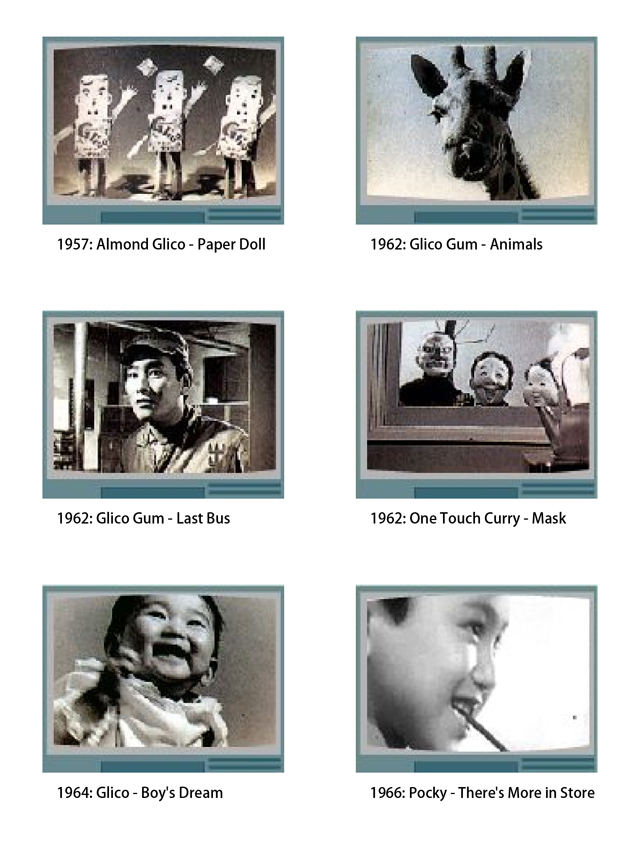
Fresh Ideas from Our Customers
Among Ezaki Glico's most loved promotions was a series of coupons that could be exchanged for gifts.
Shoppers collected the coupons in products and used them to obtain prizes.
All of the campaigns were designed around the idea of contributing to people's knowledge, good taste, and to a rich daily life.

Revolutionary Vending Machines
Glico's vending machines first debuted in 1924. They came with a unique design that, at the same time, was also an advertisement.
Adults and children alike were amazed when, in 1931, Glico unveiled a vending machine that played movies. Inserting a ten cent coin into the machine caused a video and music to play on the small set up on the vending machine, after which a piece of Glico candy and change of two cents were returned. When the machine was first installed in Tokyo, it caused a major stir. This device is so entertaining that it would be welcome on street corners even today!
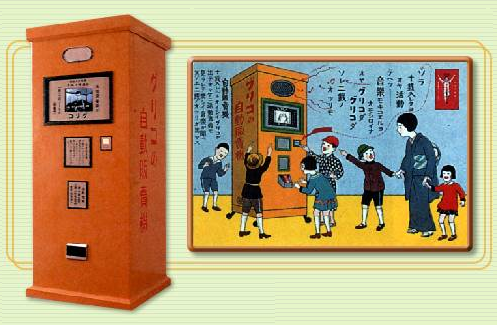
The Dotonbori Glico Sign
In the mid-1920s, when neon signs were still a rarity, Ezaki Glico was one of the first to install them in shopping arcades in Tokyo, Osaka, and Kobe.
The most famous of these still remains in the Minami area of Osaka as an emblematic icon. Adjacent to Ebisu Bridge in Osaka is a 33-meter tall neon sign that was put up in 1935. The colorful, changing design depicting a runner was a major innovation at the time and soon became the talk of the town. Even today, the image of the runner crossing the finish line attracts the attention of passersby.

Founder Ri-ichi Ezaki
Ri-ichi’s Life in Chronological Order
1882 (Meiji 15)
Born in in Hasuike Village, Kanzaki District, Saga Prefecture (currently, Hasuike Town, Saga City)
1897 (Meiji 30) 15 Years Old
Graduated from the fourth grade at Fuyo Higher Elementary School but continued studying under Mr. Sayokichi Naramura during this period
Started also selling salt.
1901 (Meiji 34) 19 Years old
His father, Seishichi, passes away. Inherits the family business
1902 (Meiji 35) 20 Years Old
Also started a registration scrivener business. He came up with an original fast calculation method, and gained a good reputation
1904 (Meiji 37) 22 Years Old
Drafted for the Russo-Japanese War, and played an active role as a nursing soldier
1907 (Meiji 40) 25 Years Old
Saw Osaka for the first time, and purchased medicine at a cheap price. Contributed in providing nursing care to cholera patients, and received a letter of appreciation from the prefecture. Taught himself advertising and sales during this period
1914 (Taisho 3) 32 Years Old
Served during Japanese-German War’s Siege of Tsingtao
1915 (Taisho 4) 33 Years Old
Started a wine business after receiving a hint from reusing empty bottles
1917 (Taisho 6) 35 Years Old
Entered the top class for wine sales in Kyushu. Established Ezaki Shokai Osaka Branch
1919 (Taisho 8) 37 Years Old
Extracted oyster extracts (glycogen) from Ariake Sea’s oyster stock
1920 (Taisho 9) 38 Years Old
Verified the clinical effects of oyster extracts
1921 (Taisho 10) 39 Years Old
Relocated to Osaka with the entire family. Established a general partnership company, Ezaki Shoten, and became president. Trial marketed Glico’s nutritional snack
1922 (Taisho 11) 40 Years Old
Succeeded in selling Glico’s nutritional snack at Mitsukoshi
1927 (Showa 2) 45 Years Old
Came up with the idea of including toys with the candy
1930 (Showa 5) 48 Years Old
Went to the US as the US industry delegate for an event held by the Taylor Society’s Japan Branch
1931 (Showa 6) 49 Years Old
Established the current Headquarters Factory in Nishiyodogawa Ward, Osaka City
1933 (Showa 8) 51 Years Old
Manufactured and sold Bisco, a yeast confectionary. Became acquainted to Konosuke Matsushita(later president of Panasonic), and created the “Monnashikai” group during this period
1934 (Showa 9) 52 Years Old
Established the Mother and Child Health Foundation with personal assets
1936 (Showa 11) 54 Years Old
Became the Japan Confectionary Export Association President
1940 (Showa 15) 58 Years Old
Established Glico Nanyo Industry, and became president
1944 (Showa 19) 62 Years Old
Received his first medal of honour
1945 (Showa 20) 63 Years Old
The Osaka and Tokyo factories completely burned down due to air raids, and foreign factories also seized
1951 (Showa 26) 69 Years Old
Received the Kikusenan (a house) from employees
1954 - 72 Years Old
Released his book, “Shobai ni Ikiru (Living for Business)”
1955 - 73 Years Old
Launched Almond Glico. Created the slogan, “Hitotsubu de Nido Oishi (Two Delicious Tastes in One Piece)”
1957 - 75 Years Old
Received his second medal of honour (recognized for nutritional snack production)
1965 - 83 Years Old
Received his third medal of honour
1966 - 84 Years Old
Became the National Confectionary Association (currently, the National Confectionary Industry Association) Honorary Executive Advisor
1968 - 86 Years Old
Became Chocolate and Cocoa Association of Japan Executive Advisor
1969 - 87 Years Old
Celebrated his 88 Year Old Party at three factories. Became Japan Confectionary Industry Committee Advisor
Received the Third Class Order of the Sacred Treasure
1972 - 90 Years Old
50th Anniversary of Establishment.
Established the Ezaki Kinenkan
1973 - 91 Years Old
Becomes the Ezaki Glico Chairman
1976 - 94 Years Old
Receives the Showa 54 Executive Award from Zaikai
1977 - 95 Years Old
Released his book, “Shoudou Hitosuji no Ki (Memoirs of Life with Only One Ideal Way of Business)”
1980 - 97 Years Old
Passed away due to respiratory failure
1980
Receives the Shogoi (Senior Fifth Rank) posthumous
1981
Further commended with a “group of statues for peace” as a contributor for mass media
Collection of Memorabilia
“Glico’s 7 Rules” — the spirit of being imaginative and creative, perseverance and never giving up, proactive and daring, simple and strong, diligence and hard work, solid unity, and consistent service— which are driving Ezaki Glico , are pearls of wisdom which were derived from Ri-ichi’s life.
Ri-ichi’s life and management philosophy can be understood from his collection of memorabilia.
Bag
The deterioration of the material of Ri-ichi’s work bag, which he used for a lifetime, allows people to feel history and expresses his passion as an entrepreneur.
Textbooks Copied by Hand
He moved up to the third year of higher elementary school with his father’s opposition. He copied the textbook he borrowed from his friend by hand because money for textbooks would not be provided. However, this turned out to be a great way of reviewing for his classes, and he graduated with top marks.
Kinranbo (Address Book)

This was a directory he made using postcards he received from his frequent clients.
He named it “Kinranbo” and always had it by his side.
Japanese Trousers and Gaiters

Ri-ichi throughout his life always placed importance on simplicity and frugality. His philosophy of “wearing good clothing for a long time” can be understood with his clothing that he carefully wore.
Fountain Pen, Brush and Yatate

Ri-ichi wrote down his passionate ideas about business during every stage in his life. He always had calligraphy tools by his side, including ink bottles, brushes and ink stones.
Scrap Book


